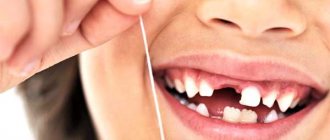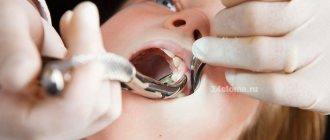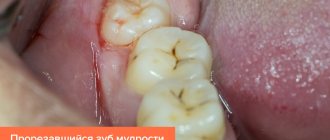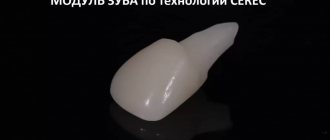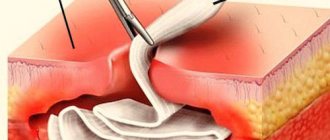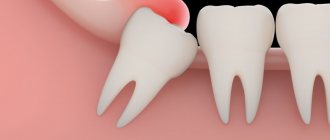If the child’s jaw develops correctly, then the replacement of teeth occurs as follows: first, the roots of the baby teeth dissolve, then the teeth fall out of the gum tissue, after which new, already permanent ones grow in their place. This is a natural process that does not require intervention.
If everything goes well, then by a certain age all baby teeth will be removed from the mouth, and straight and healthy permanent teeth will grow in their place. However, the picture does not always look like this. Sometimes parents notice that their child’s second row of permanent teeth grows even before the baby tooth falls out.
You need to pay attention to this, since new teeth can be impacted, that is, partially remain in the gums. And retention, in turn, can lead to inflammation, fever and sometimes even suppuration. Therefore, at the first signs that the child’s second row of teeth is growing, you should immediately contact a pediatric dentist.
Content:
- Causes of the anomaly
- What does a “shark” smile lead to?
- When to see a doctor
- When to hesitate to see a doctor
- How is the treatment carried out?
The situation when a molar has erupted, but the milk tooth is in no hurry to leave its place, dentists call a “shark” bite. This is due to the fact that sharks also have units arranged in two rows. In humans, such an anomaly does not look aesthetically pleasing at all. Parents usually get very scared when they see a “double” smile on their child. Should I be concerned if a tooth comes out but the baby tooth does not fall out, and what could this lead to? Let's figure it out together.
Growth of baby teeth in the second row
Hyperdontia (supernumerary tooth) in the picture
The rudiments of baby teeth are formed in the womb, so their pathologies are associated with a lack of space in the jaw for all the incisors. Among the most common reasons that provoke improper growth of baby teeth:
- unbalanced diet of a woman during pregnancy;
- deficiency of calcium, fluorine (essential microelements necessary for the formation of bone tissue);
- lack of solid food;
- uncontrolled use of a pacifier;
- heredity.
It also happens that molars and molars come in second row. This phenomenon is explained by the following factors:
- underdevelopment of the jaw, due to which there is not enough space to accommodate a full set of teeth;
- hyperdontia (superset of teeth).
Causes of the anomaly
If the permanent tooth is erupting but the baby tooth has not fallen out, it can be assumed that the child is not eating enough solid food. With a deficiency of chewing load, the roots of temporary units are in no hurry to dissolve.
The diet of modern children is indeed too “gentle”, one might even say refined. It consists of products that have undergone step-by-step heat treatment. Chewing them requires almost no effort.
If parents think that children need to be given soft and thoroughly steamed food, then they are mistaken. To change teeth in a timely manner and form a correct bite, you need to eat a lot of fresh vegetables and fruits, and other foods that require careful chewing. Then the problem of preserving primary canines, incisors and molars for too long will not arise.
Another possible cause of the problem described is the presence of scars on the gums. If in the first years of life the baby has undergone dental surgery or received a serious injury, a burn to the oral cavity, scars may form on his gums. They consist of very dense connective tissue that prevents teeth from erupting.
Useful tips
Before removing an incorrectly positioned wisdom tooth, we offer a number of tips that will help you prepare and go through the operation more comfortably:
- Try to make an appointment for tooth extraction in the morning. During the night, the hormone cortisol accumulates in the body, which helps to survive stressful situations. In addition, one should take into account the fact that the inevitable bleeding from the wound at the site of the former tooth will stop by the evening, and the person will be able to sleep peacefully.
- Eat well before surgery. As a result, saliva will be released in smaller volumes, and then you will need to leave your jaws alone and not eat for some time.
- If possible, immediately use a cold object and periodically apply it to your cheek on the way home to prevent swelling from forming. A pack of dry ice from a motorist's first aid kit will do.
- At home, rinse your mouth with clean water or medications recommended by your doctor.
- Take medications in the correct dosage, do not get carried away with self-medication and self-prescription of drugs.
Recommendations for a better rehabilitation period after removal of an impacted wisdom tooth:
- You will need to allow a blood clot to form at the site of the extracted tooth. His presence is mandatory. The clot protects the socket from the penetration of bacteria and prevents complete deformation of the gums. Dry socket is dangerous and provokes inflammation.
- Do not touch the blood clot with your tongue, toothbrush bristles, or cutlery. It is not even recommended to use mouth rinse for 2-3 days after surgery. It is better to take the medicine into your mouth, hold it for a while and spit, avoiding the chance of dislodging the clot.
- To stop bleeding, it is permissible to use sterile cotton wool or gauze swabs. It is allowed to moisten with Chlorhexidine, Miramistin. It is prohibited to use hydrogen peroxide!
- For several days you will have to eat soft food and maintain an acceptable temperature of food and drinks.
- You are supposed to temporarily give up physical activity and training. Baths and saunas, swimming pools, solariums are prohibited.
- You cannot heat the surgical area, as this will cause a dangerous inflammatory process. You can apply ice, but under no circumstances keep it on your cheek all the time. Optimal rhythm: 5 minutes cooling, 5 minutes break. If you don’t have ice at home, bags of frozen vegetables and meat from the freezer will do.
- Maintaining oral hygiene is not prohibited. The main thing is to leave the operated area alone in the first days and not try to thoroughly clean the teeth located near the wound. Disinfection can be carried out with solutions of Chlorhexidine, Furacilin, holding it in the mouth and spitting it out, without rinsing.
Medicine knows of cases when wisdom teeth are prescribed to be preserved. But if it grows, pushing neighbors, lies horizontally or rests on the roots of nearby teeth, there is no need to think twice. Such an eight is considered problematic and is deleted without regret.
If a wisdom tooth grows horizontally and puts pressure on the adjacent tooth
Removal of wisdom teeth using ultrasound in Moscow without pain and complications
What does a “shark” smile lead to?
Should you be scared if a new unit comes out, but the milk unit does not fall out? This situation should alert parents. Double dentition can lead to problems with articulation and diction. Then the child will have difficulties with the correct pronunciation of sounds and words.
Also, many patients with the described anomaly have difficulty eating food - they feel uncomfortable biting off hard foods, and when chewing them, small particles often get lodged under the gum. This means that the child will get used to swallowing poorly chewed food. This leads to disturbances in the functioning of the gastrointestinal tract, including flatulence and abdominal pain.
It happens that children who have double units in several places at once begin to lose weight. This is again due to improper chewing of food. During a meal, they swallow large pieces and because of this they swallow a lot of air. Therefore, they often have the illusion of satiety - a feeling of fullness when very little has been eaten.
Among the dental complications caused by untimely change of units:
- caries;
- inflammation of the gums;
- deposition of a large amount of soft plaque.
Therefore, you should not put off visiting the dentist. The doctor will conduct an examination and decide whether to remove the extra unit.
When to see a doctor
Doctors believe that a “shark” smile can last up to two to three months, then it is necessary to take action. If the baby tooth does not fall out within the specified period, it needs to be removed. If you do not do this, the complications described above may occur.
But what’s even worse is that the child’s bite may be disrupted. The permanent unit will take the wrong position or be at the wrong angle. Then you will have to correct its position using plates or braces, and this is always difficult and time-consuming.
It is important to know! If a permanent tooth has come out, but the baby tooth has not yet fallen out, you can monitor the situation for several weeks. It is important to ensure that the child carefully maintains oral hygiene. If after two or three months nothing has changed, you need to make an appointment for your baby to see a dentist. But this recommendation is relevant only if the little patient is not bothered by anything and does not complain of toothache.
The second stage of transposition treatment is moving the teeth into place.
Next, it was necessary to move the crown of the first premolar 1.4 from the palatal position and the reverse overlap to its rightful place. This required the separation of the bite with onlays. And, of course, the long and labor-intensive stage of normalizing the position of the tooth roots began. It is at this stage of treatment that the canine root is partially located outside the alveolar process of the upper jaw and, accordingly, the risk of gum recession is high. After a year and a half (!) of treatment, we managed to move the crowns and roots of the teeth to the correct position. And the third stage of treatment began
When to hesitate to see a doctor
If a “shark” problem appears and the child complains of pain, the gums are inflamed, swollen, you need to immediately get dental care. Also warning symptoms are:
- bad breath;
- bleeding of the affected gums;
- separation of pus in the area of inflammation;
- severe discomfort while chewing food.
You should not wait a day if the child has a predisposition to malocclusion, for example, if he has previously undergone treatment for malocclusion or one of the parents wore braces. In all these situations, removal should be carried out as soon as possible. This measure will be a good prevention of possible complications.
How is the treatment carried out?
When choosing treatment tactics, the dentist takes into account:
- how old is the patient;
- how long ago the permanent unit emerged;
- how much the molar crown appeared;
- what condition is the milk unit in;
- does the child have any complaints;
- general condition of the dentition;
- the patient has a predisposition to dental anomalies.
After conducting an in-person examination, the dentist decides whether to pull out the interfering tooth or leave it and wait until its roots resolve on their own. In the first case, local anesthesia is administered and removal is carried out; in the second, the doctor tells you when the baby needs to come for a second examination. Thus, if you deal with the problem of a “shark” smile in a timely manner, it will not cause negative consequences.
